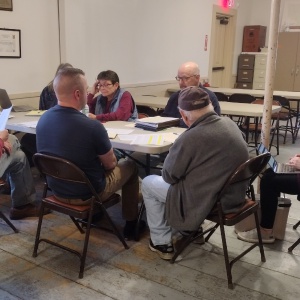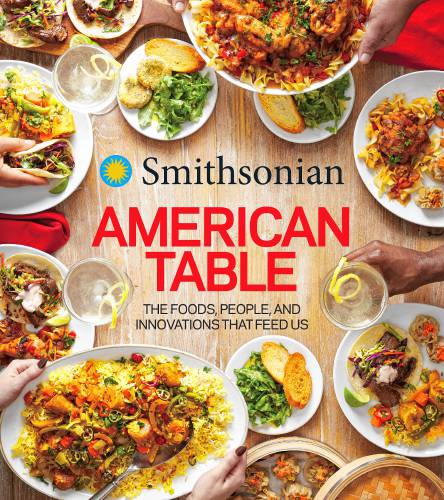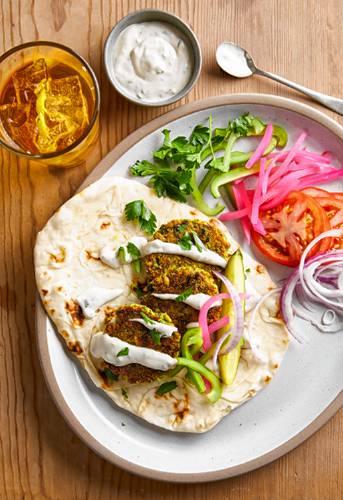A varied and appealing ‘American Table’: New book from the Smithsonian looks at American history through the lens of food
| Published: 04-09-2024 4:35 PM |
Food connects Americans to each other and to our history. Those connections were highlighted in a recent book and a library talk. The book is “Smithsonian American Table: The Foods, People and Innovations That Feed Us,” (Harvest) by Lisa Kingsley in collaboration with the Smithsonian Institution.
The talk was offered by the Greenfield Public Library last week in conjunction with the Library Speakers Consortium. It featured Paula Johnson, a curator at the Smithsonian’s National Museum of American History and the director of the American Food History Project.
In her presentation, Johnson led the audience through the book. “Smithsonian American Table” is a sort of scrapbook of images, facts, and recipes that draw on America’s culinary past and present.
According to Johnson, Lisa Kingsley was responsible for choosing which recipes to include. Nevertheless, the book clearly reflects many priorities and objects from the museum’s collection.
It begins with a brief survey of the foodways of groups of Indigenous Americans. It goes on to discuss foods associated with various parts of the country. Massachusetts, not surprisingly, is linked to the fluffernutter. Marshmallow fluff was born here.
The fluffernutter discussion did include a surprise for me, however: the sandwich was first popularized in 1918 as the “Liberty Sandwich” to encourage Americans to go meatless one day a week during World War I.
The book highlights the contributions of a variety of immigrant groups to American cuisine. It charmingly balances social history with biography by highlighting not just trends but individuals important to food technology (the inventor of the crock pot, the popularizer of Tupperware) and to food writing. Mentioning American heroes Fannie Farmer and José Andrés in the same chapter is brilliant.
At the end of her talk, Johnson answered audience questions. One was related to what she learned from Julia Child. Johnson was among the Smithsonian personnel who visited Child in Cambridge in 2001 to talk to the cookbook author and initiate the process of moving Child’s kitchen to the Smithsonian.
Article continues after...
Yesterday's Most Read Articles
 Carol Doucette of Royalston receives $15,000 from Publishers Clearing House
Carol Doucette of Royalston receives $15,000 from Publishers Clearing House
 State documents show Northfield EMS chief’s paramedic license suspended over failure to transport infant
State documents show Northfield EMS chief’s paramedic license suspended over failure to transport infant
 Plan calls for upgrades to Silver Lake in Athol
Plan calls for upgrades to Silver Lake in Athol
 Royalston’s FinCom debates proposed salary increases
Royalston’s FinCom debates proposed salary increases
 What are the protocols for emergency transport of infants?
What are the protocols for emergency transport of infants?
 Magic comes to Red Apple in Phillipston
Magic comes to Red Apple in Phillipston
Johnson’s response to this question was delightful. She said that she was surprised and moved by the participatory nature of being a dinner guest in the Child home.
“People think that you have people over, and you want to have everything done so that they don’t have to see you cooking, like there’s something wrong with seeing you cooking,” said Johnson. “But involving everybody else is the way. That’s the secret sauce to having a fabulous meal, is to have it be a participatory experience … It really was kind of shocking to me to realize that cooking, and doing so together, could be so magical.”
Johnson was kind enough to give me some time on the telephone after her presentation to discuss the book and the American Food History Project.
She explained that food had been present in many ways throughout the museum’s history. Nevertheless, the Food History Project was born in the 1990s, when she and a few other interdisciplinary curators took note of the ways in which food was increasingly influencing public discourse in this country. From the academy to newspapers, she noted, “food was on everybody’s mind.”
Their explorations of the link between food and history led to a longstanding exhibition called “Food Transforming America.” The museum collected artifacts and oral histories and eventually set up a demonstration kitchen. In short, it developed what Johnson called “a larger framework for using food and drink as a lens into American history.”
I look forward to visiting the food section of the American History Museum next time I’m in our nation’s capital, ideally during its annual food-history weekend. Meanwhile, I’m taking my time leafing through “Smithsonian American Table.”
And I look forward to the fall, when Abrams will publish Paula Johnson’s book “Julia Child’s Kitchen: The Design, Tools, Stories, and Legacy of an Iconic Space.” I hope to talk to Johnson again then.
It was hard to choose just one recipe from the book to feature, but I decided on the falafel from Michigan. This state has the largest Arab-American population in the country. I love this flavorful vegetarian dish and can’t wait to try making my own.
The recipe and the photos are from “Smithsonian American Table” by Lisa Kingsley in collaboration with the Smithsonian Institution. Copyright 2023 by Smithsonian Institution. Reprinted by permission of Harvest, an imprint of HarperCollins Publishers.
Ingredients:
for the falafel:
2 cups dried chickpeas
1 cup coarsely chopped fresh parsley
1 cup coarsely chopped fresh cilantro
1 small onion, coarsely chopped
1/4 of a green bell pepper
1 serranochile, seeded and coarsely chopped (optional)
1 tablespoon ground cumin
1/2 teaspoon garam masala
1/2 teaspoon chili powder
salt and ground black pepper
2 teaspoons baking powder
vegetable oil as needed
for the tahini sauce:
6 tablespoons tahini
1 clove garlic, minced
the juice of 1 lemon
salt, pepper, and water to taste
for serving:
pita bread, warmed
pickle spears
pickled turnips
sliced green bell peppers
sliced or diced tomato
chopped fresh parsley
thinly sliced onions
tahini sauce
Instructions:
Soak the chickpeas in 3 cups of water at least 12 hours or overnight. (Be sure the chickpeas are always covered with water. If necessary, add more water.) Drain and rinse.
In a blender or food processor, grind the beans in batches until they are almost smooth. Transfer to a large bowl. Add parsley, cilantro, onion, green pepper, and chile (if using) to the blender. Blend until almost smooth. Add to a bowl with the chickpeas and stir until well combined.
Add the cumin, garammasala, chili powder, and salt and black pepper to taste. Stir until well combined.
No more than 15 minutes before you want to cook the falafel, add the baking powder, and stir well to combine.
Form into paddies, using about 2 tablespoons of the mixture per falafel.
In a large, deep skillet, heat about 2 inches of vegetable oil over medium-high heat. Cook the falafel, 5 or 6 at a time, until golden brown on both sides. Drain on a paper-towel-lined plate.
To make the tahini sauce, in a small bowl whisk together the tahini, garlic, lemon juice, and 1/4 cup water. Add salt and pepper to taste, and thin the sauce with more water as needed.
To serve, place falafel in the middle of a pita bread. Add desired toppings and drizzle with tahini sauce. Fold and serve.
Serves 4.
Tinky Weisblat is an award-winning cookbook author and singer known as the Diva of Deliciousness. Visit her website, TinkyCooks.com.




